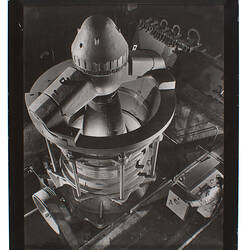Summary
The 25 Pounder was a medium velocity field artillery weapon developed in the United Kingdom and adopted by the British Army in the late 1930s. It was used as a field gun at moderate angles or as a howitzer for plunging fire at high angles. It could also be used as an anti-tank weapon if required. The 25 Pdr was produced in Australia during the World War II as Project A.2 of the Munitions Directorate. After the fall of Dunkirk in June 1940, the United Kingdom was unable to provide Australia with the military equipment it required. The 25 Pdr project was a joint effort between the Ordnance Factory at Maribyrnong and local private industry. The two main contractors were Charles Ruwolt Pty Ltd, of Richmond, Victoria, and General-Motors Holden's Ltd, of Pagewood, New South Wales. Each of these firms also had sub-contractors producing components which were assembled as complete guns by the main contractors. The first order was placed on 5 August 1940.
By 1943 there were 971 x 25 Pdr guns on order for the Australian Army, 23 for the New Zealand Army and 480 for the British Army. Estimated total cost of the 25 Pdr project was £1,259,200. Ruwolts also produced a tank mounting for the proposed Australian AC3 Cruiser tank, however, only one prototype tank was made before the project was cancelled. Ruwolts also worked with the Army Design Section to design and manufacture the Q.F. 25 Pounder Short (Aust) Mark 1, which was a smaller version of the 25 Pdr which could fire in the upper register, above 45 degrees, and could be dismantled and moved over the rough terrain encountered in the South-West Pacific Area.
Description of Content
Rear quarter view of a 25 Pounder quick firing gun howitzer with Chas Ruwolt employees W. Clark & N. Bennett.
More Information
-
Collection Names
-
Collecting Areas
-
Acquisition Information
Donation from Vickers Ruwolt Pty Ltd, circa 1986
-
Place & Date Depicted
-
Format
Glass Negative, Whole Plate, Black & White
-
Inscriptions
Circular stamp at top left of negative: 'CHAS RUWOLT PTY LTD MELBOURNE PHOTO 1024' Entered in hand written catalogue as: '1007 | 25 Pdr Gun Howitzer with 2 Trailers | Defence Dept.' Entered in hand-written subject index under 'Munitions' as: '1024 | ? 41 | 25 Pdr Gun Howitzer (with W.Clark & N.Bennett | Defence Dept | GMA | 1 negs'
-
Model Name or Number
-
Classification
-
Category
-
Discipline
-
Type of item
-
Keywords
Artillery, Artillery: Australian, Artillery: British, Guns, Howitzers, World War II, 1939-1945

